Notre Dame put up some insane numbers in the win over the Cardinal. Instead of the usual categories, it seemed like a great occasion to count down some of the best numbers from the Irish defense smothering Bryce Love and JJ Arcega-Whiteside, the extremely efficient Book-Boykin connection, and an insane amount of havoc. When you force the opponent into more three-and-outs (7) than times you let them cross midfield (5), good things happen.
Confused? Check out this advanced stats glossary.
There were so many juicy statistics, both traditional, advanced, or otherwise, that it only felt right to pull out some of the best for a countdown this week. All the usual data points will still be in here, just organized a little bit differently.

There was some unexpected garbage time in this game– by the letter of the law, it began when Notre Dame’s final touchdown that put them up 21 in the 4th quarter. However, Stanford was still (mostly) trying on their final offensive possession, at least until Jerry Tillery re-introduced KJ Costello to the turf on consecutive plays to start the series. So garbage time includes only the final Irish possession, or 5.1% of snaps.
#8 A relative draw in field position and points per scoring opportunity were wins for ND
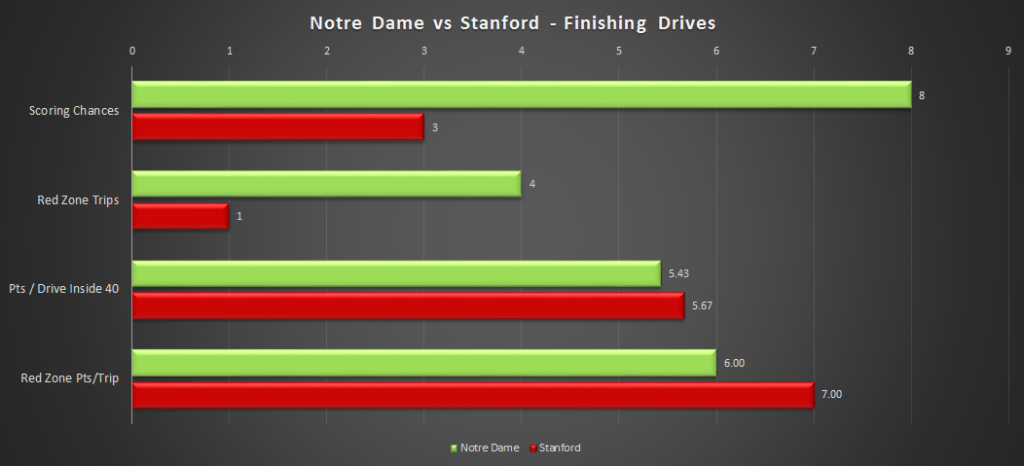
The Stanford defense entered the game best in the nation at limiting opponent scoring chances, with their defense holding opponents to 2.7 points per scoring drive inside the Cardinal 40. Notre Dame had few issues, piling up 5.67 points per trip (including a long Justin Yoon miss). The points per scoring opportunity battle, often a deciding factor in close games (a la UGA last year), was relatively even, but with an 8-3 edge in scoring chances, it hardly mattered.
Any time a game is anticipated to be close, I worry about average starting field position. Special teams have been extremely up and down during the Brian Kelly era and in recent years, despite the recent excellence of Tyler Newsome and Justin Yoon. Return yardage not gained and returns allowed have often been “hidden” disadvantages in close losses that add up.
Stanford has been the opposite – consistently excellent in both average starting field position for the offense and defense (both top 10 last year). The Cardinal had an average starting field position nearly 10 yards better than opponents – multiply that by each possession and that’s an incredible benefit. Yet in this game, Notre Dame neutralized that advantage with terrific special teams execution and defense. The only Stanford drive that started past their own 33 was following the early aggressive 4th and inches ND failure (a decision I’d take every time, but just sneak it please!).
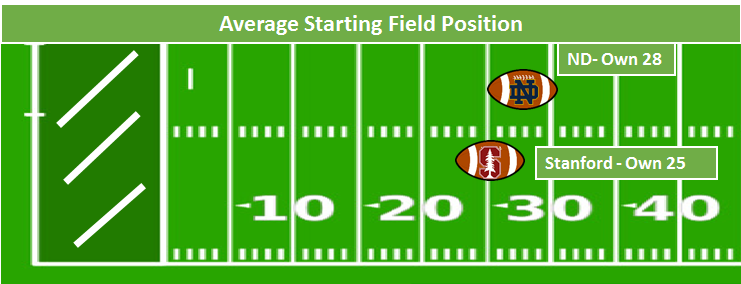
The long fields the Cardinal offense faced forced an inefficient offense to put together long drives or incredibly explosive plays to score, and they weren’t up to the challenge. Stanford had just three scoring chances (with first downs inside the ND 40), compared to seven three-and-outs in thirteen possessions.
#7 Losing the explosiveness battle doesn’t matter when you dominate efficiency
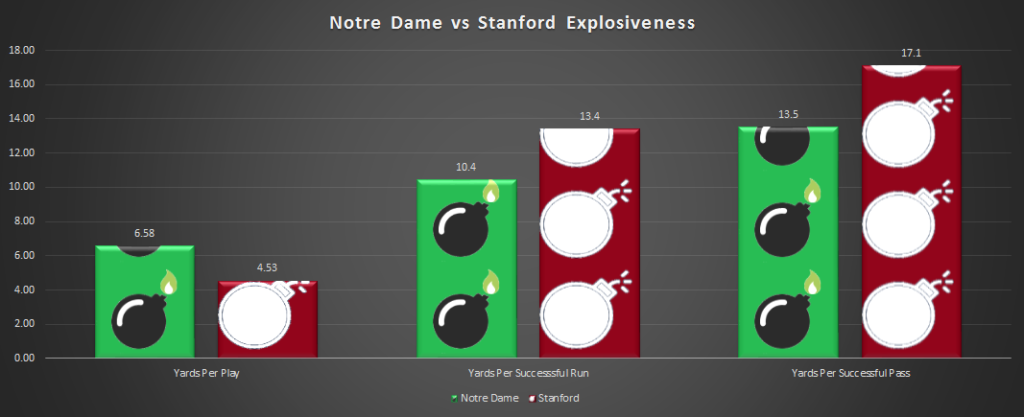
Notre Dame’s successful plays didn’t go as far as Stanford’s, who had advantages of +3.0 yards per successful run and +3.6 yards per successful pass. The problem for the Cardinal is that those successes were few and far between, with just 14 total successful plays compared to 38 for the Irish. Notre Dame also had an explosive play (run of 12+, pass of 16+ yards) on 12.7% of offensive snaps, compared to 7.8% for Stanford.
A +2 yards per play margin, especially against a top-20 quality team, is just exceptional. In the second half that advantage was 3.8 YPP, as the Notre Dame defense held Stanford to 1.5 yards per snap.
#6 Stanford’s average distance to gain on 3rd down was 11.3 yards

Costello, Love, and the Stanford offense faced nearly as many passing downs as standard downs. That’s pretty difficult to do, given that almost all 1st downs are automatically standard. And as Saturday showed, it’s extremely difficult to survive against this Notre Dame defense when they know you have to pass.
The result was a Cardinal offense that converted just 3 of 13 third down opportunities. After Costello hit JJ Arcega-Whiteside on a dumb jump-ball to even the score at 14, the next drives for David Shaw: punt, punt, halftime (after moving backwards 9 yards in three plays), punt, punt, field goal, punt, interception, punt. A “manball” offense became fairly one-dimension, rushing just six times for 14 yards in the second half.
The entire first half it felt like Costello was just barely getting throws out in time, and with that extra split second was able to connect on some long gains. That miniscule advantage disappeared in the second half, and led to poorer decision making and ultimately a few sacks. The Irish offensive line, meanwhile, allowed just one sack, with a lot of credit to Ian Book for terrific awareness and some nifty moves in the pocket.
#5 Bryce Love and JJ Arcega-Whiteside, neutralized and inefficient
Despite two stuffs on Love’s first carries of the game, it looked like this game could turn into a shootout at one point. Love broke the long 39-yard touchdown run, and had successful runs on 5 of his first 8 carries. From there on out it was a dominant performance by the Irish defense, with just one successful run on his remaining nine attempts.
Similarly, JJ Arcega-Whiteside had a decent start, but then was taken out of the game by the Irish pass rush and Julian Love. Arcega-Whiteside entered the game averaging 24 yards per catch and over 100 yards per game, but was held to just 3.3 yards per target (30 receiving yards total).
#4 Dexter Williams – explosive AND efficient!
The explosiveness Williams showed off in his first post-shadow suspension carry was no surprise. 21 carries, however, was downright startling, and Dexter showed off his ability to gain tough yards and be an efficient lead back in the process. Williams was successful on 48% of his runs, a well above average number, and even his unsuccessful runs averaged 2.9 yards per carry. That effort was central to preventing the 3rd and super-long down and distances that plagued the Stanford offense.
#3 Miles Boykin was targeted on 42% of Ian Book’s passes, and made them count
The Book to Boykin connection was spectacular, with the big receiver getting 14 targets from Book’s 33 non-garbage pass attempts. Boykin caught 11 of those passes, and averaged 9.63 yards per target for the game. All 11 of those receptions were also successful plays – no stat-padding with a 10-yard gain on 3rd and 15 here.
Book’s accuracy was exceptional for a second straight gain, with great decisions and placement leading to few opportunities for Stanford to find a takeaway. The Cardinal came in with a top-3 defense in terms of pass break-ups per game, but deflected just three passes on 33 pass attempts. This play in particular was a beauty – Book reading the defense on an RPO, seeing a blitzer and getting an accurate throw out quickly to Boykin, who took advantage of some great blocking and cruised in for an easy score.
Book, by the way, led the passing attack to a 57% success rate, topping his 50% mark from Wake Forest a week ago. As a reminder, in all of 2017/18 Brandon Wimbush hit 50% just once, against Michigan State.
#2 The Irish defense posted an insane 37% havoc rate
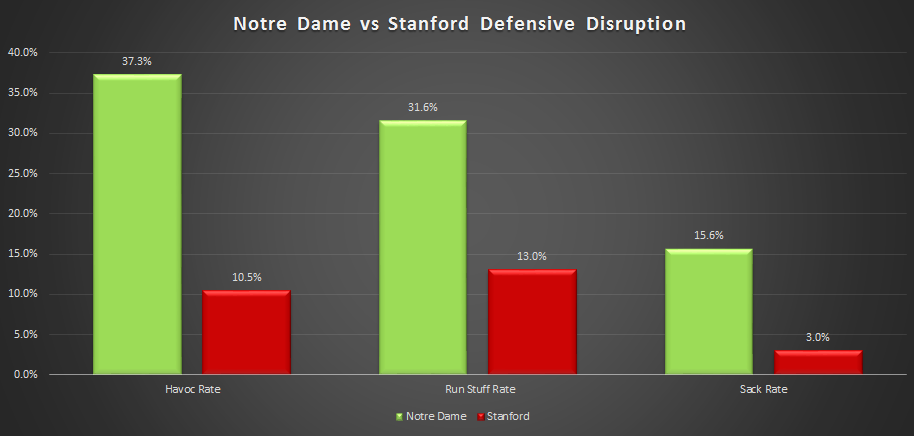
In just 51 defensive snaps, the Notre Dame defense tallied 10 tackles for a loss (including five sacks), forced a fumble, had eight pass break-ups, and a beautiful Te’von Coney interception. Add that up and you have a 37% havoc rate, by far the highest I’ve seen since I began tracking these numbers. Havoc doesn’t even include all run stuffs (only tackles for a loss, not runs for zero yards), where the ND defense bottled up 31% of Cardinal rushes for no gain or a loss.
The man getting a lot of deserved love is Jerry Tillery, with a record-tying four sack effort. Pro Football Focus also credited Tillery with two additional QB hits and a pressure. Being a starting college quarterback would be awesome in many ways, but if a 300+ pound man as strong as Jerry Tillery is going to hit me around one out of every five times I try to throw I think I might politely decline the opportunity.
The front seven as a whole was outstanding, including guys like Daelin Hayes and Julian Okwara, who didn’t bring down Costello for a sack but brought constant pressure. The linebackers didn’t put up a ton of tackles without many plays run against them, but Coney, Tranquill, and Bilal each had at least one pass break-up and part of a tackle for a loss. They are fast and mean and up next is a Virginia Tech offense already under four yards per carry against regular old FBS teams, pray for them.
#1 A monstrous efficiency advantage, fueled by strong coaching and execution
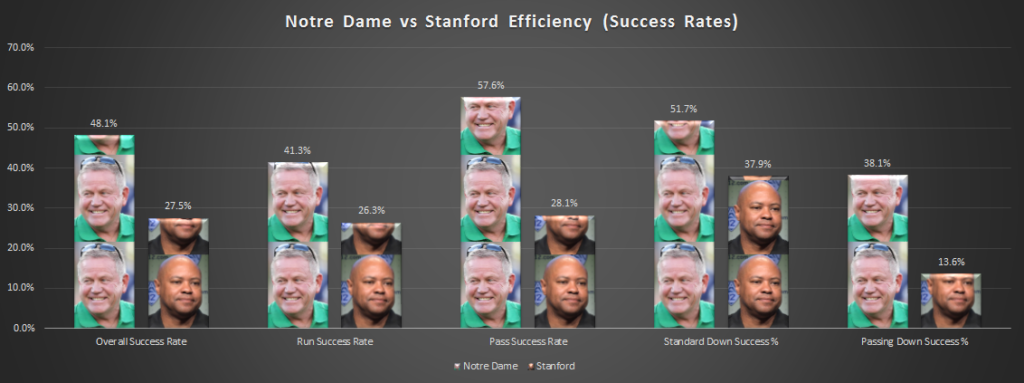
The Irish were +21% in success rate against Stanford. Yes, that previously top-10 Cardinal team, that had been a massive thorn in Notre Dame’s side. Across the board David Shaw’s offense struggled – running the ball efficiently, passing efficiency, especially trying to pass when Clark Lea’s defense knew a pass was coming. There were also runs on 3rd and 8, 3rd and 18, 3rd and 21, and 3rd and 28, when hope was so bleak that it seemed better not to risk KJ Costello’s health or an interception.
Chip Long also flexed a lot in this one, especially with the dagger throwback pass to Alize Mack that put the Irish up 21. With Ian Book at the helm the offense has been extremely balanced, efficient, and excellent converting in the red zone. Book has unlocked the screen game and RPO’s in a new way for the ND offense, and while he may not always be as sharp with his accuracy and decision-making as he’s been in these two games (he’s had NBA Jam flames on the football since about the 2nd quarter versus Wake), you get the sense Long is just getting started.
On to Virginia Tech
The final whistle hadn’t yet sounded before the conversation revved into high-gear. Notre Dame’s schedule is a cakewalk, they’re going to the playoff! Would a 12-0 Irish team make it in even if Stanford and Michigan fade in the second half? What are the trap games remaining on the schedule?
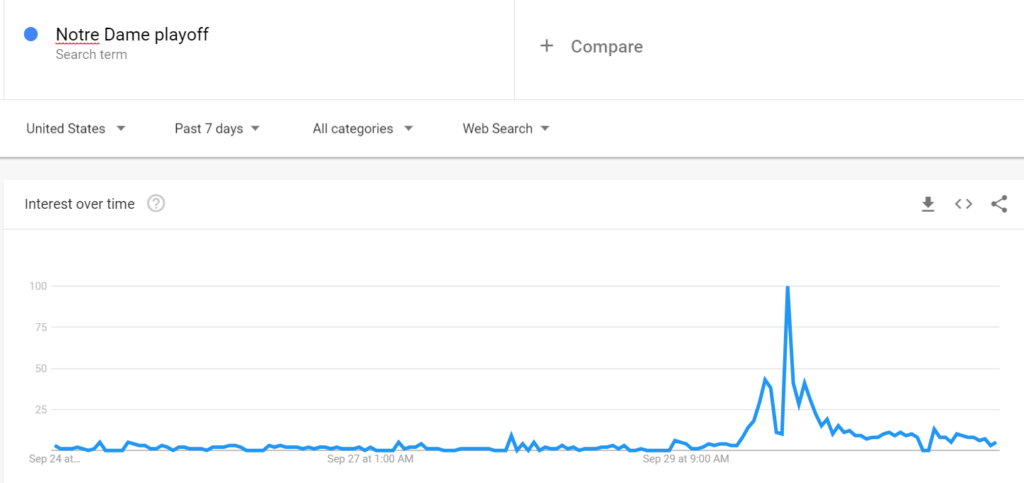
The reality is that every week from here on out will be a mini-gauntlet, minus cheeseburger week. This team should be favored every week, but every team left on the schedule presents its own special danger. Pitt? Beat previously undefeated Miami last year, and Clemson the year prior. Navy will try very hard to replicate what Army almost pulled off against Oklahoma, playing keep-away and shortening the game. Syracuse almost beat Clemson and did last year, and Eric Dungey may be the best QB the Irish face this season. USC still has immense blue chip talent, as does FSU (who at the very least, won’t be worse than they were in September). Oh, and I’ve heard things can get difficult at night in Lane Stadium.
A quick look at what this edition of the Hokies brings to the table:
1. Strong stats on defense, a big weakness, and questionable competition
The Tech defense looks like the usual Bud Foster unit on paper. The Hokies have allowed just 2.65 yards per carry, 3rd in run stuff rate, and are 17th in overall opponent success rate. They’re also top-40 in sack rate, with a havoc rate ranked 11th nationally. They’ve been disruptive and stingy against the run.
But they’ve also been gashed by big plays – ranked 128th in FBS in opponent explosiveness. They gave up an 85 yard run to FSU in the opener, and a ton of chunk plays en route to allowing 632 yards to Old Dominion. The pass defense in that game was abysmal, although they rebounded nicely last week against Daniel Jones and Duke.
Still, you look at the competition, and the Hokies have not faced a murderer’s row. Opponent adjustments as a result place VT with the 57th ranked defense, a far cry from Foster’s usual output. Opposing offenses are currently ranked 109th (FSU), NR (FCS Williams & Mary), 87th (Old Dominion, who again passed for nearly 500 yards), and 62nd (Duke). There is talent there, especially on the defensive line, but also some gaping holes (particularly in the secondary) left by graduation, the draft, injuries, and dismissals.
2. A dangerous passing game, but pedestrian run attack
Against the same four (weak) opponents, Virginia Tech hasn’t been held below 8 yards per pass attempt. The huge news in the loss to ODU was the loss of sophomore QB Josh Jackson to a broken leg. Kansas transfer Ryan Willis stepped in and was excellent last week against the Blue Devils, averaging 11.9 yards per pass attempt en route to a 332 yard day with 3 scores and no picks.
Sophomore Damon Hazelton has been a dangerous deep threat, averaging 23.2 yards per catch and leading the team with 30 targets (15 receptions). The pass game – first with Jackson, and now one game of Willis – is top-20 nationally in both marginal efficiency and explosiveness. Justin Fuente knows some offense, and they’ve protected the QB fairly well (35th in sack rate allowed). Again, these defenses aren’t the ’85 Bears, but this explosiveness is a new dimension for an offense that struggled mightily in that category last season.
The run game, meanwhile, has shined against overmatched opponents (averaging over 300 yards on the ground and 6 yards per carry against William and Mary and Old Dominion) and struggled in two conference games. The Hokies managed just 112 yards on 2.8 YPC against FSU, then 81 yards on 2.0 YPC against Duke.
3. Beamerball still shows up
You may have seen that Virginia Tech will unveil a Frank Beamer statue prior to Saturday night’s game – a nice move to get the crowd in a frenzy, as if they wouldn’t be already. The Hokies are ranked #2 in Special Teams S&P+ – with a kicker that hasn’t missed an attempt, and punter that’s allowed just four returns on 22 punts for a grand total of zero yards. VT also had a blocked punt for a touchdown against the Noles in Labor Day Monday. The Irish can’t afford an early return or blocked kick that could ignite the crowd and get the home team believing they can pull the upset in Blacksburg.

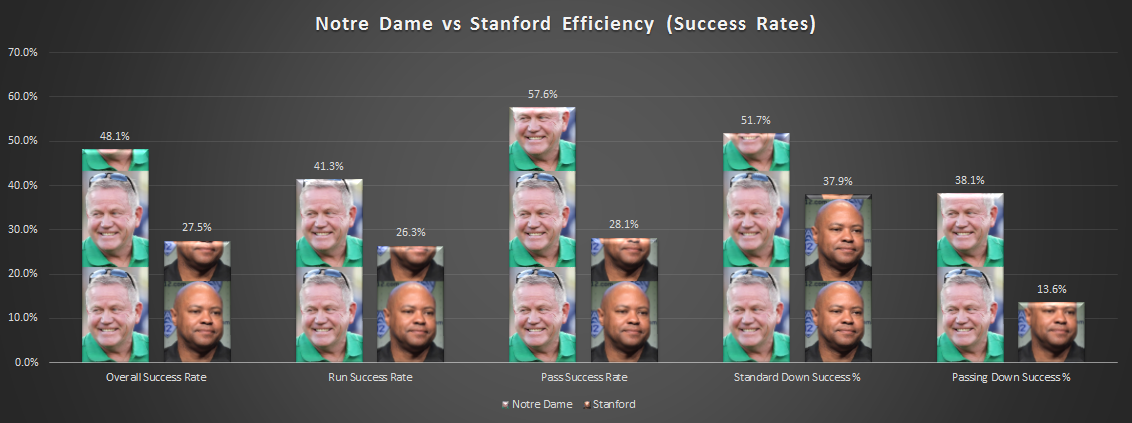



I just want to see I really enjoy these advanced stats reviews. As my handle indicates I’m a big baseball fan and have enjoyed the advanced stats wave in that sport and am really happy to see it and learn it here. It makes me stomach turn when I see people at 247 mention total defense and other antiquated stats. Not really anything relevant to add but thanks for putting these together
I thought you were a Stanford baseball fan? back to back champs in ’87/’88!
thank you though, it’s pretty incredible that people use counting numbers as often as they still do. I wonder if they don’t know better or just want to use the most eye-catching numbers to attract eyeballs or support their point of view. but especially early in the year, when a lot of teams have played 1/2 cupcakes, those non-opponent adjusted (and non per-play) numbers are hot garbage.
I love the “BK smile” vs. “Shawface” chart.
Arguably the greatest graphic this site has ever produced.
Man I’ve been waiting for this since Book threw the Mack TD. So beautiful.
Really really excited for Dex. I was looking forward to him coming back with the explosiveness, but that efficiency was unexpected. Not a single carry went for negative yardage; in fact, no carries even went for 0 yards. Welcome back!
The TD drive before half to go up by a TD was masterful by Book. Every single play was at least a 9 yard completion or a run for positive yardage by Book. Hell of a job in a huge spot.
There were a lot of huge, timely moments, re-watching and looking back:
1) holding to a 3/out after the failed 4th and 1, and Stanford punting on 4th / 2 from our 45
2) the drive to respond after Stanford tied it at 7-7, featuring the huge Kmet catch on 4th/2 and Weishar TD on 3rd and 2
3) that Book / Boykin two minute drill, culminating in the Claypool touchdown
4) another 3/out after we didn’t take advantage of getting the ball after halftime up 7
5) another 3/out (a theme!) after the missed Yoon fg, still just up 7 early in the 4th
it really felt like a game that would be tight despite our seeming advantages until suddenly it wasn’t.
I remember when f Michigan unveiled a Red Berenson statue against ND last season. Hopefully there’s something to that curse.
Love the review. Not sure I agree about the Holtz-ian talk up about rest of the way. Pitt just gave up 38 and lost to UNC. Northwestern, Navy and FSU look weaker than expected. The Hokies pulled a typical Chokies act vs ODU. Syracuse isn’t half bad but they are Syracuse. By the transitive property of ND > Stanford by 3 TD’s > USC by 2 td’s ND is a million times better.
You’re right it could be an upset/flat performance on any week but by any measure they’re 5-0 and passed what should be the 2 toughest tests.
I agree that the schedule doesn’t look strong. I’d say that if we get through this weekend, we’ll have passed most of the tough tests, as well as exorcising another demon – winning in a tough road environment in a big national game with high expectations. We haven’t done a lot of that as of late.
Although none of the teams are especially daunting as of right now, I think the travel schedule in November presents its own challenge (thanks Jack!)
My brother, who coached against VaTech several times says Lane Stadium at night is brutal, worse than Penn State whiteout. Hopefully we don’t have another Miami situation. I don’t think we will.
I’m with you. Va Tech clearly derped against ODU, but let’s not pretend that’s an accurate level of where they are at. We should also not pretend that ND has never done something similar (maybe not at THAT level, but a certain UCONN game comes to mind). ODU got VT’s worst, and a QB injury early in the game didn’t help VT’s cause. Now the backup has another game under his belt (and he played well against Duke). It’s at home, and arguably their biggest game of the season. I expect the place to be lit, and I expect that if we give them reason to believe, VT can make it close or even win. If we play like we did this past week, we can take the crowd out of the game and it won’t be as close. But I think it’s extremely foolish to look at them and go “but they lost to ODU, it’ll be a cakewalk.”
It’s still very very difficult to go undefeated. And the downside to this easy schedule is that 1 loss basically guarantees we’re out of the playoff. I still think it’s going to take a monumental coaching effort to get this team to the playoff, just because of how hard it is to win 12 straight games.
Don’t forget that a lot of the remaining games are on the road (4 counting the “road” game vs. Syracuse)…recent history shows that ND does not show up to dominate on the road like they do at home. Also, there’s a post-Navy hangover game in there, plus USC waiting at game 12. I have confidence in this team, but I also have recognize that a perfect season is not a given.
ahem…at NC State last year
At least the Post-Navy Hangover Game of the Year is against a pretty bad Northwestern team this year.
That just gave Michigan all they could handle. Yes, we beat Michigan, but we all know the transitive property isn’t a rule, more of a vague guideline when it comes to college football.
Pitt beats 1 major team in an upset every year, no matter how bad they are. Northwestern just gave Michigan all it could handle, and play them after coming back cross-country from playing Navy. Navy is Navy. VT is a decent team with an incredible home field that had everything go wrong in a game they expected to win just by showing up (I feel like that should be a lesson for us). Syracuse just took Clemson to the wire and is legit good. Transitive property is, as I just said elsewhere in this thread, a rough guideline and not a scientific principle when it comes to CFB, and USC is again a cross-country trip after playing on the east coast.
FSU? Yeah, we better kill them by 30. The rest, I’m not saying we lose, but it’s pretty silly to think we couldn’t lose to any of those teams. I hope the coaches and the players don’t consider all of those wins before they happen, because that’s how you end up ODU’d.
I think we SHOULD win all these games, but as MikeyB said, winning 12 games no matter who you play is hard. That’s why S&P+ still has us as only a 23.5% chance to do it, despite being “better” than all the remaining teams we play. I’d say our 3 “most likely to lose” games are Syracuse, VT, and Northwestern, with the first two being our two toughest remaining opponents, and NW being a post-Navy, post-cross country hangover spot. Pitt is horribad this year, and while I worry they’ll have one of their patented upset games, I don’t think they beat us, maybe just scare us. We’ll handle Navy because our D will have 2 weeks to prep and our D-Line is scary disruptive. Assuming we get out of that without injuries, we’ll kill FSU. And USC is a house of cards, there’s no way they’re beating us if we roll in 11-0 and smelling the playoff. And I don’t think we’re losing more than one game, if we lose one–the only reason we lose is by taking our eye off the prize, and that shouldn’t happen more than once (shouldn’t happen at all, but it does).
I’m just going to drop a plug here for Pete Sampson’s column at The Athletic. It’s a pay site but in my mind well worth it. Great article today that is a film review of 5 plays with Tranquill. Also has previously done these film reviews with Love and Mustipher & Bars. I feel his writing is more even handed and less sycophantic than it was at II
Only pay for it if you’ve renewed your 18S premium subscription though, priorities
I’m a lifetime donor to 18S Premium. Platinum Level, baby!
Platinum is weak. I’m all up in that quadruple Uranium level. Mansions and benzes kid.
Plus the permanent glow it gives your skin is a nice bonus.
18s premium is a sham. I still havent gotten my stained bar coaster autographed by Murtaugh
But, did you get you lock of 100% grizzly fur, with certificate of authenticity signed by Larz’s Sunday school teacher? That’s the collectors item
We’ll talk to our logistics partner to see what’s going on there. In the meantime, did you see the 18S After Dark Premium Subscription renewal gift? Not fit for print, but use your imagination.
Just want to second that. I got 5 months for the price of 1 at Irish Illustrated and feel like I still kind of got ripped off, but The Athletic (including Pete’s stuff there) is worth paying for, particularly if you can get some kind of discount.
A couple things before I even read your article:
1. The Brian Kelly and David Shaw faces are amazing. I appreciate you going the extra mile.
2. We beat Stanford so bad that *none* of their blogs had (as of last night) posted a review of the game. Praise the Lord. The writers on their blogs were, for the most part, incredibly smug before the game. I can’t wait to drink their whiny tears.
Stanford’s fans aren’t weak, classes just aren’t in session again! And it’s hard to get there during Cali rush hour!
Haven’t seen this mentioned here: Terry Jillery Walter Camp defensive player of the week, Ian Book Maxwell player of the week
Tillery racking up the attention this week because he’s also the Bronko Nagurski National Defensive Player of the Week.
Since Ian Book took the reins against LSU last year, he has completed 74% of his passes for 780 yards, nine touchdowns and just one turnover. That’s at a very solid 8.4 yards per attempt, which is exactly what Riley Ferguson was at in his only year under Chip Long at Memphis. Excluding sacks, he’s also rushed 31 times for 164 yards at 5.2 YPC and another three touchdowns.
Since Book took over this year, ND has risen 30 spots in S&P offense to 37. Offensive percentile performance in games where Wimbush was the primary starter since Stanford last year: 26%, 33% (Citrus Bowl where Wimbush had two ineffective quarters of play), 64%, 36%, and 50%. In two games for Book, the offense has performed at 88% and 87% with a 10.5% increase in marginal efficiency. And for the record it was at 70% last year for Book’s first start against UNC.
The average sack rate for an NCAA QB is around 6%, and Ian Book for his career so far is at 4.55%, including a sparkling 2.8% for his action this year (would rank 8th in 2017). In 16 games as starter, Wimbush’s sack rate was 8.3% last year and 7.3% this year, which would rank in the 100s if you extrapolate that out. Keep in mind that last year he had maybe the best offensive line Notre Dame has ever fielded and still took sacks at a ghastly rate.
LSU and Stanford both had top 20 defenses per S&P (LSU at 17, Stanford at 11), while the highest ranked defense ND will play for the rest of the year is USC at #28 right now. Basically, Book has already played the best competition he’ll face unless ND gets to the playoffs.
All in all, it’s not hard to see the difference between Book and Wimbush in the stats. And for the sake of gloating I said in Eric’s Citrus Bowl Review that Book would be the better QB. I just wish I wasn’t in the process of moving to London so I could’ve affirmed that during the QB transition before Wake Forest. 😉
The one thing you don’t prove here is that Book would have beaten Michigan behind an OL that couldn’t block with practically no returning skill production. I’m thrilled we have both guys and that Wimbush is such a stand up teammate to support his team even when it means his star doesn’t get to shine.
It’s honestly up in the air whether a Book-led ND offense would’ve beaten Michigan, but we now know that performance was Wimbush at his best. If he had played like he did against Ball State or even Vandy, ND probably loses to Michigan by double digits.
I’m not trying to knock Wimbush as a person, but the constant inconsistency and inaccuracy was killing the team to the point where our own offense was starting to wear down an excellent defense. I think the Michigan game was the perfect time for Wimbush to have his one-off performance just like he did against MSU last year.
I had given that some thought too..
If they knew Book was THIS good 8 months ago, they could have put a game plan in for him. You have to say he’s surprised everyone with just how solid, consistently and excellent he has played. So I don’t really blame them, guess there are some things you just can’t see coming and this would be one of them.
I think they liked Book but put immediate effort into crafting a way for Wimbush to use his physical (running) tools to slash Michigan up all offseason. And hoped that would be the easier way so there would be no doubt or division in the locker room that it should be Wimbush’s team and job to lose.
But, he did play himself out of a job and prove he didn’t progress enough with poor Ball St/Vandy performances. And then the coaches got lucky since it turns out it looks like the backup was a stud all along. (Plus a real kudos to Wimbush for not openly having a boo boo face or making life any tougher than it had to be. Tough to be a great teammate in his situation but seems like he’s handled it well which says a lot about his character, IMO).
There is a game plan for Book, it is the playbook. There was a separate game plan for Wimbush as it turns out.
I think we ignore one critical thing. Book wasn’t this good 8 months ago. The improvement for Book from UNC to today is night and day. There was probably slight improvement from UNC to LSU, but that was probably hidden by the defense of LSU. If we still had the Book of UNC, we would not be enjoying this as much.
Very good points. Which might foreshadow re-opening the (mostly NDN discussed) topics of BK ruining QBs, and Tom Reese being a poor QB coach. Let’s keep hoping for an upward trend… to keep trending up. Lane Stadium will be the next challenge.
I think it is impossible to judge Tom Rees after one, or even two, seasons. There are not enough data points. There is nothing at this point that Kelly can do to satisfy NDN, except quit.
That wouldn’t satisfy them either. He would quit wrong, or have just one more thing he should’ve done before quitting. Or he’d have the wrong attitude about quitting. Or his next job would be a step down so he should’ve just retired. NDN is sour enough to find fault anywhere!
Is it now ok to invoke TOS in name?
Eh… We’d rather keep the sniping to a minimum, honestly. It’s no secret that there’s no love lost between our sites, but it doesn’t serve much purpose to our conversations here to get hung up on slinging arrows at them. Even if it’s fun every once in a while.
I concur, and was not trying to stir the pot.
Mostly a futile waste of energy. That being said, DC Irish 84 and Dannan 14 are spot on…
Anyway, to focus on the positive, as we often do here (one reason I do treasure this site and you all) — I see no reason not to give T Rees some credit for helping coach up Ian to be getting better, and Brandon to help him be a truly classy teammate. Hopefully more data points will confirm all of this!
Yes, this.
I actually think what BK has said is (for once) the truth: Book wasn’t this good through spring–not good enough he seized the job. The staff felt “upside” was higher in Wimbush, and that for ONE matchup, against Michigan’s D, Wimbush’s athleticism would be the best plan to beat them. And it worked–see 22 yard runs on 3rd and 18. They then went into a slate of games where they could give Wimbush a shot to solidify his hold on the starting job if he played well as a passer–even designing the Ball State gameplan to force him to pass–and he didn’t play well enough through two games, so it was time to give Book his shot. And he rocked the audition. I can buy that the coaches thought Book wouldn’t be ready for Michigan. But it’s clear moving forward, he’s the best option.
The sack rate is something that’s really incredible to me. This O-Line is good, not great, and in pass blocking sometimes they’ll just completely miss on a read. So far, Book has been just as good as Wimbush at making the first pass rusher miss. I never in a million years would have predicted that. He’s even got the Jimmy Clausen “spin and run away from the pass rusher” move down (although I’d like to see him cut down on that one a bit).
The difference is that Book’s spin is tighter and he mostly gets away. Clausen mostly got caught when he did it.